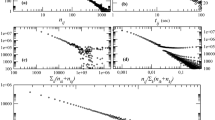Abstract
We study here the clustering of directed social graphs. The clustering coefficient has been introduced to capture the social phenomena that a friend of a friend tends to be my friend. This metric has been widely studied and has shown to be of great interest to describe the characteristics of a social graph. In fact, the clustering coefficient is adapted for a graph in which the links are undirected, such as friendship links (Facebook) or professional links (LinkedIn). For a graph in which links are directed from a source of information to a consumer of information, it is no longer adequate. We show that former studies have missed much of the information contained in the directed part of such graphs. We thus introduce a new metric to measure the clustering of a directed social graph with interest links, namely the interest clustering coefficient. We compute it (exactly and using sampling methods) on a very large social graph, a Twitter snapshot with 505 million users and 23 billion links. We additionally provide the values of the formerly introduced directed and undirected metrics, a first on such a large snapshot. We exhibit that the interest clustering coefficient is larger than classic directed clustering coefficients introduced in the literature. This shows the relevancy of the metric to capture the informational aspects of directed graphs.
This work has been supported by the French government through the UCA JEDI (ANR-15-IDEX-01), EUR DS4H (ANR-17-EURE-004) Investments in the Future projects, and ANR DIGRAPHS, by the SNIF project, and by Inria associated team EfDyNet. The authors are grateful to the OPAL infrastructure from Université Côte d’Azur for providing resources and support.
Access this chapter
Tax calculation will be finalised at checkout
Purchases are for personal use only
Similar content being viewed by others
References
Alon, N., Yuster, R., Zwick, U.: Finding and counting given length cycles. Algorithmica 17(3), 209–223 (1997)
Barrat, A., Weigt, M.: On the properties of small-world network models. Eur. Phys. J. B-Condens. Matter Complex Syst. 13(3) (2000)
Bollobás, B., Borgs, C., Chayes, J., Riordan, O.: Directed scale-free graphs. In: ACM-SIAM Symposium on Discrete Algorithms (2003)
Bykin, P.O., Roychowdhury, V.P.: Leveraging social networks to fight spam. Computer 38(4), 61–68 (2005)
Fagiolo, G.: Clustering in complex directed networks. Phys. Rev. E 76 (2007)
Gabielkov, M., Rao, A., Legout, A.: Studying social networks at scale: macroscopic anatomy of the twitter social graph. In: ACM SIGMETRICS Performance Evaluation Review, Vol. 42, pp. 277–288. ACM (2014)
Granovetter, M.S.: The strength of weak ties. In: Social networks. Elsevier (1977)
Kwak, H., Lee, C., Park, H., Moon, S.: What is twitter, a social network or a news media? In: Proceedings of the 19th International Conference on World Wide Web, ACM (2010)
Latapy, M.: Main-memory triangle computations for very large (sparse (power-law)) graphs. Theoret. Comput. Sci. 407(1–3), 458–473 (2008)
Mislove, A., Marcon, M., Gummadi, K.P., Druschel, P., Bhattacharjee, B.: Measurement and analysis of online social networks. In: ACM IMC, pp. 29–42 (2007)
Myers, S.A., Sharma, A., Gupta, P., Lin, J.: Information network or social network?: the structure of the twitter follow graph. In: Proceedings of the 23rd International Conference on World Wide Web, pp. 493–498. ACM (2014)
Sanei-Mehri, S.-V., Sariyuce, A.E., Tirthapura, S.: Butterfly counting in bipartite networks. In: ACM SIGKDD, pp. 2150–2159 (2018)
Sarämaki, J., Kiveläa, M., Onnela, J.-P., Kaski, K., Kertesz, J.: Generalizations of the clustering coefficient to weighted complex networks. Phys. Rev. E 75(2) (2007)
Silva, N.B., Tsang, R., Cavalcanti, G.D.C., Tsang, J.: A graph-based friend recommendation system using genetic algorithm. In: 2010 IEEE Congress on Evolutionary Computation (CEC), pp. 1–7. IEEE (2010)
Trolliet, T., Cohen, N., Giroire, F., Hogie, L., Pérennes, S.: Interest clustering coefficient: a new metric for directed networks like twitter (2020). arXiv preprint: arXiv:2008.00517
Ugander, J., Karrer, B., Backstrom, L., Marlow, C.: The anatomy of the facebook social graph (2011). arXiv preprint: arXiv:1111.4503
Wang, J., Fu, A.W.-C., Cheng, J.: Rectangle counting in large bipartite graphs. In: 2014 IEEE International Congress on Big Data. IEEE (2014)
Watts, D.J., Strogatz, S.H.: Collective dynamics of small-world networks. Nature 393(6684), 440 (1998)
Author information
Authors and Affiliations
Corresponding author
Editor information
Editors and Affiliations
Rights and permissions
Copyright information
© 2021 The Author(s), under exclusive license to Springer Nature Switzerland AG
About this paper
Cite this paper
Trolliet, T., Cohen, N., Giroire, F., Hogie, L., Pérennes, S. (2021). Interest Clustering Coefficient: A New Metric for Directed Networks Like Twitter. In: Benito, R.M., Cherifi, C., Cherifi, H., Moro, E., Rocha, L.M., Sales-Pardo, M. (eds) Complex Networks & Their Applications IX. COMPLEX NETWORKS 2020 2020. Studies in Computational Intelligence, vol 944. Springer, Cham. https://doi.org/10.1007/978-3-030-65351-4_48
Download citation
DOI: https://doi.org/10.1007/978-3-030-65351-4_48
Published:
Publisher Name: Springer, Cham
Print ISBN: 978-3-030-65350-7
Online ISBN: 978-3-030-65351-4
eBook Packages: EngineeringEngineering (R0)




